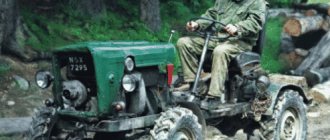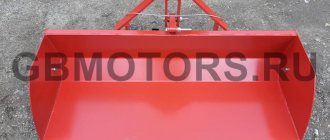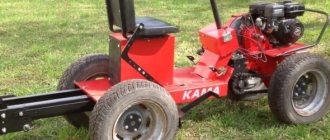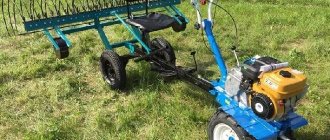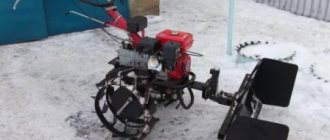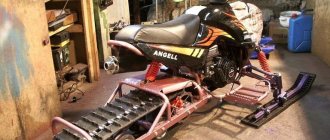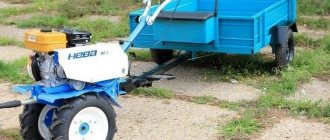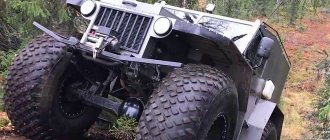Many people are interested in whether it is possible to make a walk-behind tractor with their own hands. A heavy walk-behind tractor or compact walk-behind tractors are indispensable assistants in agriculture, but not all farmers and summer residents have the opportunity to purchase such equipment. Therefore, if you have certain skills, knowledge and skills, you can assemble a walk-behind tractor with your own hands. In order for a self-assembled motor cultivator to serve for a long time, a project diagram is created. It is necessary to correctly measure the parts, purchase materials and tools, and complete technical drawings and dimensions of components. You can use one of the instructions from folk craftsmen who write on special forums on how to make a walk-behind tractor with your own hands.
Any recommendations on the Internet on how to make a walk-behind tractor yourself should be checked against reviews. It’s good if the users of such homemade walk-behind tractors are friends or acquaintances. Then their reviews can be trusted; in other cases, all advice on assembling and using homemade devices should be checked.
How to make a homemade walk-behind tractor from a ZAZ gearbox
Most agricultural workers produce a homemade walk-behind tractor, which uses a ZAZ engine.
Why him? But because this device has good performance. Its parameters often exceed those of popular brands. In addition, according to many experts, this option becomes suitable for any farmer. Despite the fact that domestically produced products often cause complaints from consumers, this time there is no doubt about the high quality. For a walk-behind tractor, the engine produces 3.5 horsepower. This, of course, is not very much, but it will be just right for this device. The best option is to create a device without chains and belts. First, the crankshaft is removed from UD1, then the clutch and gearbox are removed. A “body” is welded into a cone on the flywheel. The crankshaft needs to be shortened and a thread needs to be cut for the bolt.
DIY mini tractor made from LuAZ
It is necessary to take the remains of a tractor that was assembled on the basis of the gearbox of a LuAZ vehicle. The design needs a little modification. Thanks to the U-shaped profile, there is an option to extend the frame. In addition, you need to change the direction of the revolutions. This unit has a driven rear axle, homemade hubs, wheels from trailer-type agricultural equipment, and a UD2 engine. The device is also distinguished by a single-disc clutch, control using a steering wheel, combining the engine and transmission using a belt, and a mechanical brake system. After the gearbox there is a plate with a basket, shaft and flywheel.
The rear wall of the ZAZ engine has been cut off. The gearbox gear is pulled onto a splined shaft. On the reverse side there is a flywheel. This design is manufactured in a factory. Two oil-type pumps are installed on the device, which are intended for the HPS and a separate hydraulic system. If it is not needed, the second device is turned off. Next, you need to attach the gearbox to the plate and hang it from the frame at the front and rear. The steering wheel provides comfortable control.
Many parts, such as wheels, fenders, axles, and hood, are removed from a car that has already failed during use. If desired, these elements can be welded from metal yourself. The drive sprockets, which have bearings, are attached to the frame. In addition, it is possible to change their position in order to tighten the chains. The entire filling of the device ensures the movement process. The rear axle includes two axle shafts located in a “stocking”. It is also manufactured at the factory.
The steering linkage cam is equipped in the center along with the suspension pendulum, which is located in front. Thanks to these design features, “skidding” on turns and uneven terrain is eliminated. The problem of brakes is solved with “clamp” pads, which are made by hand. A mechanical drive is used. The linings taken from the Moskvich machine are pre-cut to the required dimensions. They are attached to the blocks. A finished part is used as a cylinder, which is pre-shortened in the workshop.
As a rule, it is located in the center. However, it can be moved to the right, creating a trapezoidal enhancement. This allows you to make a hole in the frame. It is necessary so that the “rear axle” drive, which is directed to the hitch, can come out. The pedals are connected by a common axis. Its shaft supplies the brake on the left.
Hydraulic pump drive
The peculiarity of the device is that during its manufacturing process you can experiment with absolutely any element. Some of them are not required at all. For example, in a hydraulic system you can do without an oil filter and a pump. In the process of manufacturing the drive, an existing six-spline device is used, and homemade sprockets are used. To make a mini tractor yourself, it is recommended to create a drive using the pump of a VAZ 2101 car. A moped sprocket is equipped instead of an impeller. The diameter of the pulley increases.
1. If you lower the lever down, the “drainage” of the lower part of the cylinder cavity opens. As a result, the piston moves down. This happens due to the influence of gravity of the device, as well as the pressure of the liquid that flows through the upper fitting from the pump.
2. If you set the lever up, the “drainage” of the upper part of the cylinder opens. As a result, liquid enters its lower cavity from the pump. In this case, the valve closes and the equipment is concentrated at the top.
3. If you set the lever in the neutral position, the fluid is not able to flow from the bottom to the top. This is prevented by closing the valve. The structure does not fall down.
4. When the lever is placed in the neutral position, the pressure at the top of the cylinder increases when the wheel hits an uneven surface. As a result, the valve opens and liquid begins to flow down. In order to return the plow to the required position, you need to hold the lever in the “down” position.
By analyzing the operation and design of a mini tractor, the following shortcomings can be identified:
1. Spontaneous switching off of certain gears occurs during loading. This happens because the torque action is displayed at the gearbox in the opposite direction, that is, counterclockwise.
2. The hydraulics stop working, which occurs during the oil heating process.
3. The engine can wear out quickly. In addition, it is demanding to operate.
However, the main drawback is maintainability. In order to dismantle the gearbox, it is necessary to disassemble the entire structure of the tractor. Using this knowledge, you can make the device yourself. You don't have to be a professional to do this.
Stages of work on making homemade products
The next thing to do is to highlight the individual stages of work:
- The kinetic scheme is an important stage in creating a mini-tractor with a VAZ engine.
- Creating a tractor frame. It can be made from channels and corners. All frame joints are carefully welded. Now you should inspect the metal for rust and coat the frame in several layers with a metal primer.
- They are starting to finalize the project's chassis. It is imperative to check the brake system and, if necessary, replace its components.
- Wheel installation. If you are going to install large wheels in diameter, then you need to take care of the axles and brakes by altering their structure.
- After this, the engine is mounted on a previously prepared frame, which has already completely dried after painting with primer, the protective casing for the mini tractor from the VAZ is welded and mounted.
- They install the seat, steering and create platforms for mounting attachments.
But you don’t have to make platforms for hanging, but just make a snow dump. But you still need to attach a 50 kg counterweight at the front so that the unit does not tip over under heavy loads at the rear. You also need to attach headlights of your choice.
A hole for a trailer would also come in handy. With its help you can hitch a cart or other cargo. The next important element, without which the VAZ 2106 mini-tractor will not move, is the battery. You can use a regular car battery. For it, you need to weld or make a storage compartment out of plywood. It is better not to attach the battery tightly in place, but to make it removable so that it can be charged. After all, it is much more convenient to take the battery and bring it to the garage than to drive the car. Think through every detail to create a mini tractor with a VAZ gearbox with a Zhiguli engine.
A Zhiguli tractor, assembled with your own hands, can save the situation when a special machine is required to work in the field. This is felt especially strongly by farms (both small and large) and summer residents who have a plot of more than 10 acres. It is worth noting that in villages there are often old cars that have outlived their useful life. However, they can be brought back to life in a new role.
A homemade Zhiguli tractor allows you to solve absolutely all problems in the field and does not require special spare parts and components - standard AvtoVAZ spare parts can be found in any corner of the former CIS. The only drawback that a homemade Zhiguli tractor will have is that the fuel is relatively expensive gasoline (almost all industrially produced tractors run on diesel fuel), which makes such homemade products more expensive to operate, but this drawback is covered by cheaper spare parts Lada, and most importantly - low cost of production.
The VAZ-2121 Niva is best suited for making a tractor; you can make a good mini tractor from a UAZ. In the latter case, it is possible to use a diesel engine, which makes its operation more economical (that is, the disadvantage of such a modification is actually eliminated). However, in the absence of a Niva or UAZ, you can use engines from other models: VAZ-2101, VAZ-2103, VAZ-2104-2105, VAZ-2106, etc. You can purchase engines from the latest Zhiguli models on the auto parts market - they are more economical than their predecessors, which will significantly save energy resources during operation.
How to make a walk-behind tractor with your own hands using a Lada box and a VAZ rear axle
Many people are interested in whether it is possible to make a walk-behind tractor with their own hands. A heavy walk-behind tractor or compact walk-behind tractors are indispensable assistants in agriculture, but not all farmers and summer residents have the opportunity to purchase such equipment. Therefore, if you have certain skills, knowledge and skills, you can assemble a walk-behind tractor with your own hands. In order for a self-assembled motor cultivator to serve for a long time, a project diagram is created. It is necessary to correctly measure the parts, purchase materials and tools, and complete technical drawings and dimensions of components. You can use one of the instructions from folk craftsmen who write on special forums on how to make a walk-behind tractor with your own hands.
How to assemble a walk-behind tractor yourself
Let's look at how to assemble a walk-behind tractor with your own hands. Parts that can be used for DIY are taken from old motorcycles and scrap metal. As an engine, which is often installed on homemade motor cultivators, you can use a motor from Druzhba - a chainsaw.
This engine has sufficient power to allow the use of various attachments. This significantly expands the functional use of motor cultivators. Many people install the engine from the Ant scooter on their walk-behind tractor, which has excellent characteristics and parameters for working in their summer cottage.
To create a walk-behind tractor at home, you will need the following spare parts and materials:
- Steel corners measuring 36x36 mm or pipes 60x50x2 mm. From these parts you can assemble a frame for a walk-behind tractor.
- Engine fully assembled.
- Fuel tank.
- Exhaust system.
- Air filter.
- Kickstarter.
- The steering wheel on which the clutch and gas handles should stand.
The following tools will help you make a walk-behind tractor with your own hands:
- Welding machine.
- Drill.
- Vise.
- A set of horns and spanners.
- A grinding machine on which a special disk must be installed for cutting metal.
Preparation for work
Trimming this rather bulky part must be done in several stages. And the first of them is good preparation for the procedure. So, we will need the rear axle itself (usually from disassembly - used, but in excellent condition, you can get it cheaper there).
Next are the tools that we will use to carry out the work: an angle grinder, welding, a vice, a standard case with the necessary keys, screwdrivers and other small items. Good tools for measuring the exact cutting length are also important. For the convenience of completing the task, there are stands on which the part is fixed. Also about the place of work:
A dry, well-lit and heated (if you work in the cold season) garage or box, with the ability to connect welding, is desirable. That's it, it seems. Oh yes, and your ardent desire to produce a homemade product for fun or for practical purposes.
{banner_content}
Scheme for creating a walk-behind tractor
A homemade walk-behind tractor from a ZAZ gearbox consists of 2 wheels, is self-propelled, and is assembled with an engine that has forced cooling of the cylinder head. It is carried out using air. The motor must be selected so that it can operate at different speeds, including low speeds, and be capable of performing large volumes of work. You can install a motor from a scooter and remove other elements from it:
- control cables;
- engine mounts;
- handles;
- chains;
- arc, frame.
The brakes on the walk-behind tractor are used both factory-made and our own. Homemade brakes will allow you to take into account the necessary parameters and loads.
Having everything you need at hand, you can make a homemade mini-cultivator at home quickly and without any problems. A walk-behind tractor based on the ZAZ gearbox is created as follows:
- A U-shaped frame is made from pipes.
- You need to turn the wheel axle on a lathe.
- Make 3 homemade hinges that are installed on the front and control rods. This approach to assembly was used by designer Arkhipov when he made his walk-behind tractor. Hinges were used to connect the cultivator, steering wheel and plow.
- Weld a steel pipe onto the frame of the car, on which there should be an axle. It is needed to carry out the tension that is transmitted to the gearbox. In order for such tension to be constantly present, it is necessary to make a rocker arm.
- Weld the gear shift knob. A small piece of steel pipe is suitable for these purposes.
- The chassis can have chain pitches of 12.7 and 15.9 mm. The sprockets on the chain have the following characteristics: output shaft - 11 mm, secondary shaft - 60 and 20 mm, running axle - 20 mm.
The main stages of manufacturing a walk-behind tractor:
- The frame is welded, on which the engine must then be installed, 2 pipes in the form of an arc.
- The fuel tank is attached between them.
- We assemble the motor using a bracket, which is also welded to the frame.
- You need to attach a motor with suspension to the axle, and then all the parts are connected to the frame arches.
- The secondary shaft is mounted.
- Control cables are being pulled.
- The chains are stretched.
Manufacturing or selection of ready-made structures
With access to a wide range of components: a junkyard of old equipment or abandoned property of a repair shop, it is possible to manufacture a gearbox with an accurate selection of the gear ratio.
However, such a complex structural element requires serious metal processing equipment. You can select a housing of the appropriate size, drill holes for the shafts on the bearings, and assemble the structure no worse than the factory one.
However, experience shows that the selection of ready-made structures with minor modifications is much more effective. As an example, consider a homemade walk-behind tractor based on an engine from an IZH motorcycle.
A proprietary gearbox is used, with the ability to change speeds. The standard gear ratio is not enough, although a small sprocket on the output shaft of the gearbox, combined with a large sprocket from the drive wheel, already provides a good reduction in speed.
The shaft, installed in the bearing podium, is equipped with another small sprocket, which, using a second chain, transmits torque to the wheels. In turn, a large diameter star is installed on the drive axle.
The result is a design with two-stage rev reduction and solid torque. By using the motorcycle gearbox, you can select the required speed without using the throttle. The engine almost always runs at idle speed, which prolongs its service life.
No less popular is the use of a ready-made gearbox from the Ant scooter.
It is not necessary to use the entire wheeled platform; it is enough to install your rollers on the bridge. By using the gearbox from the selected power plant, you will get the optimal ratio of power and speed.
Video: modification of the gearbox of the Neva walk-behind tractor.
To cultivate a plot of land requires a huge amount of physical effort. Some farmers enjoy physical labor, so they are quite satisfied with the use of basic tools. But most summer residents use walk-behind tractors, which they often assemble with their own hands, to plow acres of land on their plots.
Transmission and clutch
A self-made motor cultivator based on a VAZ gearbox or based on a manual transmission must have an excellent transmission. It is needed in order to transmit rotating torque from the motor to the wheels, change the speed and direction of the machine. This part of the walk-behind tractor consists of units that are connected in series to each other:
- gearbox;
- differential;
- clutch;
- Transmission.
Gearboxes and gearboxes are divided into several types:
The most optimal solution is to install a gear transmission on the walk-behind tractor, which has several forward and reverse speeds.
In motor cultivators, you can use transmissions that consist of 2 gearboxes - a gear (installed on top) and a worm (mounted on the bottom). This design is suitable for light and medium-sized machines, but for heavy walk-behind tractors it is necessary to install more modernized versions.
The gear-worm transmission can be equipped with a centrifugal automatic clutch. The belt drive on gearboxes of this type can also act as a clutch, which performs its functions through a tension roller and a control mechanism (rod and levers).
An important part of the transmission and clutch is the release bearing. The speed of torque transmission depends on the release bearing.
Drawings of homemade walk-behind tractors
Scheme of a walk-behind tractor based on a Minsk motorcycle
Drawing of a walk-behind tractor based on the Voskhod-3M motorcycle
Drawing of a walk-behind tractor based on a scooter
Chassis and steering
The chassis is a frame onto which all parts of the walk-behind tractor and wheels must be attached. When there is no frame, its functions are performed by the transmission, and the motor and wheels should be mounted on it.
You can put parts from the car on the chassis, for example, from the rear axle of a Zhiguli.
This is a suitable option for changing the distance between the wheels and setting the track to the desired width. If there is no rear axle from a Zhiguli, then one from an Ant or an all-terrain vehicle will do.
It is customary to use 2 types of wheels on walk-behind tractors:
- Pneumatic.
- Weighted metal ones that have lugs. They are bolted to the wheels or welded on. Additionally, other weights can be attached to the metal wheels to increase the weight of the walk-behind tractor and improve traction with the ground.
The walk-behind tractor is controlled through a system of levers, gear shift rods and steering wheel. Some models have operator seats, but the vehicle is generally operated manually only. The required structures can be located on the following nodes.
On the left side of the steering rod there is a control lever for the clutch and emergency engine stop.
The gas, wheel drive and brake levers are installed on the right side.
Design features
A homemade walk-behind tractor is most often used to perform simple but labor-intensive work:
- plowing of land;
- hilling up plantings;
- mowing grass or tops;
- application of organic fertilizers.
You can upgrade any walk-behind tractor with a ZiD engine or any other, make it on large wheels, with a belt drive.
Often, craftsmen prefer to reassemble such units using old spare parts from such mechanical devices:
- chain saws of the “Friendship” type;
- scooter;
- motorcycle;
- washing machine.
An electric motor may also be required in this technique, for example, to create air cooling, so a motor from a vacuum cleaner or a small refrigerator can also be useful.
If a person owns a tool and understands the structure of equipment, then making a walk-behind tractor is not difficult. In terms of material costs, this can cost a minimal amount, while prices for a good unit start at $300. If everything is done correctly, a new device created by yourself can be in no way inferior in reliability and performance to imported models such as Cayman walk-behind tractors.
Often craftsmen use old units from the Druzhba saw as engines. At the same time, the walk-behind tractor is easy to operate; even a non-professional or a minor can work with it. The power plant is able to withstand significant loads without stalling even at low speeds.
This indicator is important for the following work:
Even branded walk-behind tractors cannot perform such work.
Reverse gearbox for walk-behind tractor
In a reverse gearbox, reversal is performed according to the following scheme: there is a clutch between the opposite bevel gears, which sit freely on the drive shaft.
Being in extreme positions, it clings to the splines on these gears. Therefore, when the clutch engages, the direction of rotation of the gear changes. The gears must be of the helical type. The clutch drive mechanism is a traditional fork or cam.
Advantages and disadvantages
The advantage of a homemade walk-behind tractor is that it can be made based on the needs that exist in a given farm. For example, a practical unit should do most of the work on plowing and harrowing. In accordance with these “requests,” the frame is made to the required size, and the engine is adjusted so that it runs at low speeds. It is necessary to tidy up the unit that secures the attachment.
One of the disadvantages is that it is not always possible to perfectly fit all the blocks taken from different mechanisms to each other with your own hands.
In order for all the components to work together, you need to be fluent in many engineering professions and have a fair amount of practical experience.
Tools and materials
A small tractor greatly helps farmers in their work. They can cultivate the land of household plots and summer cottages, and harvest crops. The big advantage of the unit is that a wide variety of attachments can be connected to it. A compact mini-unit is good for everyone, but it costs a lot of money. Even Chinese manufacturers have begun to significantly raise prices in recent years. Therefore, some craftsmen make small units with their own hands, and the quality of these mechanisms is not inferior (sometimes even superior) to factory products.
Before starting such work, you should understand how this or that unit is structured, how it works, and what its features are. Such equipment on a farm is needed, as a rule, for 3-4 types of work, so when creating a unit you can “place accents”, for example, strengthen the frame (if it will bear an increased load) or install wider wheels if the main work will be carried out in field.
The beam/bridge can be made with additional fasteners, since often factory analogues do not have the required strength coefficient. A homemade tractor may have no cabin, but this is not always justified, especially when working in hot or cold seasons. The PTO is a power take-off shaft that makes it possible to operate mounted implements. Types of shafts:
- mating,
- autonomous;
- working synchronously.
The frame can be made from “6” angles or pipes with a diameter of 45 mm. To make the structure more stable and durable, metal plates (6 mm thick) are welded at the corners. The gearbox can be taken from VAZ
It is important that in its working condition there are at least three forward speeds and one reverse. Traction can be “borrowed” from a motorized stroller
The steering column is quite suitable for a domestic car like “Zaporozhets”. It is also possible to make a mini-tractor with different engines - both single-cylinder air-cooled and four-stroke carburetor. Such power plants are ideal for creating agricultural machinery.
The benefits of creating a miniature tractor with your own hands:
- low price;
- you can make a unit that best suits your personal needs.
The disadvantages include:
- the process of creating a tractor may seem labor-intensive for those who have not worked much with machinery;
- car engines run on gasoline, which is more expensive than diesel fuel;
- You are not allowed to drive on federal highways using this type of vehicle; you may receive a fine.
How to do it?
The example that will be given below (master V. Arkhipov) will be a good illustration of how you can assemble an all-wheel drive walk-behind tractor at home with your own hands. The cables can be taken from Ant, ZAZ, scooter, the rear axle - from VAZ, the box - from Zhiguli . The main frame is made from pipes with a diameter of 40-45 mm. Modular hinges are installed as rods, which will be a reliable “link” between the power plant, the plow and the steering wheel.
Another tube is welded onto the supporting frame, which ends with an axis. In this way, the tension of the cables going to the box is challenged. Tension is realized using a moving lever.
This unit has a number of advantages. First of all, we should mention the hinge block. A non-dynamic rigid connection (which is present in many models) makes the mechanism difficult to operate. The articulated joint is more productive - you can change the direction of movement during the plowing process, while the plow can remain in the furrow.
This topic is quite relevant, because due to soil resistance the car is constantly “driving” in different directions. Additional attention and effort are often required to “keep” the mechanism exactly on course.
The axis of the device is arranged according to the vector of translational motion. During plowing, the entire block is slightly “rotated”. Moreover, the optimal angle can actually be corrected using the articulated rods.
Plowing depth can be maintained automatically. It should be said that the frame is equipped with a field board. It regulates the force that is responsible for driving the plow into the ground, especially when it burrows. If it protrudes from the ground at too large an angle, then the angle of attack increases accordingly, then the unit again enters the soil by a given amount .
The future walk-behind tractor is equipped with a supporting frame and wheels, which can be made of metal; they will have good grip on any soil. To reliably “couple” the frame with the suspension, two bent tubes are usually used, between which a fuel tank is mounted.
To properly equip the engine, a bracket is used, at the end of which there is a steel axle (its length is 15 cm).
A bracket is welded to the frame itself, and the engine is placed on the axle. The entire power block is fastened with arcs. Upon completion, another shaft is installed, control cables and chains are pulled.
Such a unit can perform many different jobs and be a universal device. To do this, it is enough to simply replace the spare parts intended for the plow with the elements necessary for the functioning of the cultivator.
While moving, the unit deepens a furrow in the soil and at the same time places potato tubers there. To “close” the tubers, you should simply use the walk-behind tractor a second time . The algorithm for hilling plants is exactly the same.
The use of different blades allows you to adjust the working width; it is also possible to “pick up” potatoes that were not collected during the first pass. The walk-behind tractor can be used for cleaning snow and wet leaves; you just need to “pick up” the hard brush.
Any walk-behind tractor consists of the following components:
- engine;
- transmission;
- controls;
- gearbox;
- aggregation system.
It is best to choose a two-stroke engine; a motorcycle engine from IZH-Planet is ideal for this.
Transmissions in walk-behind tractors are as follows:
- gear (it can be found most often on tractors or tanks);
- gear-worm;
- complex (gear and worm) with an additional pulley.
The system of various controls contains:
- switching speeds;
- gasoline supply;
- brake.
The control unit consists of several levers that are responsible for:
- speed switching;
- fuel supply to the engine;
- brake.
The mechanism must be equipped with an aggregation device that ensures reliable coupling with mounted equipment.
Making tractor wheels
Let's consider creating the wheelbase of a mini-tractor. You can install wheels removed from a passenger car on a homemade Perelomka tractor, but here you will need to take into account a number of factors. So, the wheels installed on the front axle should be approximately 14 inches in diameter. If you choose smaller wheels, there will be a high risk of the structure not working properly in the future: the tractor runs the risk of falling into the ground. However, you cannot go too far with the dimensions, otherwise the tractor driver will have to make enormous efforts to perform even the simplest maneuvers: the steering wheel will be very difficult to turn. However, this task can be simplified a little if the steering column is equipped with a hydraulic booster.
Please note that the tires on the tractor must be equipped with good lugs. This will make the mini tractor, created with your own hands, more maneuverable, reduce the load on the wheelbase and simplify work on it.
For greater maneuverability, a self-made mini-tractor called Framelka can be equipped with a hydraulically strengthened steering column. Hydraulics can be removed from any other agricultural equipment. To assemble such equipment, you will need an oil pump, which will be driven by an engine. This element creates the correct pressure in the hydraulic motor.
If you want to achieve maximum ease of operation, you can make a fracture all-wheel drive mini tractor yourself. All-wheel drive, even made with your own hands, allows you to achieve good maneuverability. Of course, all-wheel drive makes assembling all the components of the structure more difficult, since you will have to make a shaft with all the high-quality and correct connections.
If you are going to make a tractor with all-wheel drive, it is recommended to find a video review that will show and tell you in detail how and what needs to be done. Remember that assembling a mini-tractor will require extreme care.
A 4x4 fracture minitractor is constructed with your own hands using a variety of spare parts, most of which are borrowed from cars, but they are not the only ones that will be needed during work. For example, in order to make a rotating unit or a breaking unit, you need to acquire a welding machine, a drill, fasteners and tools for connecting parts. The fracture assembly for a mini tractor requires special attention when assembling and you may need to turn to professionals for at least advice.
A do-it-yourself tractor cannot be done without installing a driver's seat. As a rule, the control system, including the seat, is installed after the main part of the DIY work with the frame is completed. This technique often uses seats taken from passenger cars. This item can be easily purchased at any automotive store. Remember that the steering wheel must be placed at a comfortable height for the tractor driver. It should not be located too low above the knees, but you should not set it too high either: your arms can get tired quickly.
Important How a tower crane is installed and dismantled on a construction site
Russian cars are an excellent source of spare parts for the construction of agricultural machinery. If you have minimal skills and abilities, you can, without much effort, make a tractor that will differ little from factory products. This will allow you to save a significant part of the family budget or completely make the tractor for free if you already have all the necessary elements and do not need to buy anything.
You don’t have to make the entire design yourself; you can take a ready-made machine as a basis and remake it. For example, craftsmen often make a Perelomka mini-tractor from LuAZ: they borrow the transmission and brake system from it, and make the rest so that it is convenient to work with.
The mini tractor from LuAZ is popular primarily because these machines are extremely reliable in operation. The main thing when assembling a homemade product is to focus on the width of the wheelbase, since if you plan to plow hard soil, you will need wheels with a larger diameter than for normal work. As in the case of a completely homemade design, assembly should begin with a frame for which a steel pipe is used. The steering column comes from the machine on which you are making your tractor. The rear axle and engine can also be taken from LuAZ.
Assembling a walk-behind tractor from scratch
If you are going to construct an entire walk-behind tractor with your own hands, or even an entire mini-tractor, before starting work you should think about the feasibility of implementing such a project. The modern market can offer the user many models of domestic and Chinese-made walk-behind tractors, whose characteristics allow for work of low and medium difficulty. Moreover, the price of such equipment is quite affordable for many users. So the project to create your own walk-behind tractor should have the following advantages:
- low cost;
- the possibility of using old spare parts from equipment, cars or motorcycles when assembling;
- improved performance compared to the factory equivalent;
- additional functionality.
Parts, assembly of new units and complete set of walk-behind tractor
Unfortunately, not many parts can be used from an old VAZ for a walk-behind tractor. Here is a list of what will be useful in one case or another:
- engine, since the Zhiguli has a gasoline engine, this option is not the most economical;
- fuel tank and fuel system parts;
- exhaust gas removal system;
- air filter;
- starter;
- steering wheel, gas and clutch levers;
- gearbox, transfer case;
- wheels;
- rear axle - useful for assembling a trailer structure.
In fact, this is everything that can be used from VAZ. It is very difficult to make a homemade walk-behind tractor from a Zhiguli bridge and similar VAZ models without many transformations, so you have to use only individual parts of the chassis.
Usually the engine for a walk-behind tractor is a diesel one, so it’s worth delving into old motorcycle equipment, for example, the same motorcycle. There are some homemade products with saw motors, but they are used for light earthworks.
The choice of engine is very important, so focus on the type of work that will be performed by the walk-behind tractor. For medium loads with plowing the land and harvesting crops, a motorcycle engine is sufficient, but for more labor-intensive work, a car engine will be required.
In some cases, if there are not enough parts, you can buy original spare parts for walk-behind tractors and use them in the design. This option should be considered only if the drawing contains recommendations and examples for converting purchased spare parts.
Since we need to get a working prototype, try to follow all instructions as closely as possible and carry out all work according to the diagram and drawings.
Engine
As noted above, the main driving force of homemade mini-trucks is motors from mopeds (Soviet magazines recommended using the IZH-56 engine), and low-power boxer engines.
The advantage of the latter is the ability to lower the center of gravity and low vibrations, which becomes important when it comes to a heavy body mounted on a passenger chassis. It is difficult to imagine that a homemade truck will require good dynamics and acceleration. Torque is critical when choosing, but some high-speed engines can be used in conjunction with a reduction gearbox. At low speeds, four-stroke diesel engines demonstrate a good N˙m value.
And in the diagrams you can often see ZAZ power units, but what is more important is that they can also often be found on actually working equipment. The durability of these engines, equipped with a good, by the standards of our reality, atmospheric cooling system, is worthy of special mention.
Tractor engines from T-16, T-25, etc. have proven themselves quite well. Motors like the D-21A1 can be easily adapted for domestic needs: power - 25 hp, maximum rpm - 1800. However, the standard starter from these engines may not work Russian cold weather, so the original starter is often replaced with a starter from the T-40.
Additionally, the motor can be improved by adding a cardboard filter to it, and given its dimensions, it is better to place it behind the cabin. Engines from the T-16 can be connected to the GAZ-51 gearbox using the original clutch, although in this case you will need to use a sheet metal adapter with holes for the mount and shaft.
Mini tractor
A mini tractor differs from a walk-behind tractor in that its power is higher, which means that the scope of application of equipment on the farm increases and changes. You can quite easily make a mini tractor from walk-behind tractors by connecting a suitable trailer. Here you can use both a factory model of a walk-behind tractor and its homemade analogue. You will get this kind of walk-behind tractor from a Zhiguli bridge and with a trailer. You should still choose a diesel engine, preferably a more powerful one. This assembly option also involves the use of a special drawing.
The Zhiguli will benefit from not only the rear axle, but also the gearbox. Some modifications will be needed:
- The top of the gearbox is cut off, and it is bolted to a homemade frame. The pulley ratio is maintained at 1:4.
- A chain drive is pulled from the gearbox to the axle, and adjusting sprockets are installed with an efficiency ratio of 1 to 3.8.
- The bridge itself is bolted to the walk-behind tractor frame.
- The wheels are made from Zhiguli wheels. You can disassemble the structure along the weld seams, and then narrow the disk itself by inserting a smaller part into a larger one and scalding the resulting part by welding.
The option involves the use of 2 ready-made units: a walk-behind tractor and a trailer.
Types of gearboxes
There are worm and chain devices. The differences between them are small, but quite important. The difference lies in the characteristics inherent in the two different types: efficiency; angular velocity; number of gears; number of shafts and ratio between gears.
Relatively cheap walk-behind tractors are often equipped with non-separable gearboxes for simplified assembly . In this case, the service life is significantly reduced and additional possibilities are eliminated:
This indicates the low quality of the material used to manufacture the gearbox, and that most of the parts will not be sleeved. The diagram will give an idea of the principle of its operation and service life.
Expensive walk-behind tractors are equipped with gearboxes that are more complex in design and allow further assembly and disassembly. Maintenance can be carried out by correcting all the shortcomings in the operation of the device.
Repairs are carried out in order to extend the service life. It is recommended to replace faulty parts with more expensive ones. Timely lubrication will also extend the service life.
In most cases , the gearbox converts speeds , that is, the angular speed is quickly and efficiently transformed into a low one. There will be a high angular velocity on the input shaft, and a low one on the output shaft.
To prevent unexpected breakdowns, regular high-quality maintenance . When changing speed in steps, the gearbox is called a gearbox. When a step system is not used, the device is called a variator.
Using the VAZ rear axle
What you can definitely make with your own hands is a multifunctional trailer from the rear axle of a Zhiguli.
To do this you will need a few materials:
- steel tubular blanks 60x30 and 25x25 mm;
- wheels and springs from the rear axle of a Zhiguli;
- sheet pieces of steel from 0.8 mm thick;
- channels, duralumin sheets from 2 mm thick.
The trailer body can be assembled in various ways. One of the most common options is wooden with metal corners and screw fastenings. The working process is as follows:
- The wooden frame is attached to the metal structure of the rear axle.
- Metal parts are welded together.
- The transverse crossbars are made from a 25x25 mm profile; tubular blanks are useful for the spars.
- From 25x25 mm corners we make a metal frame for the frame and weld it to the lower bridge.
- Next, the beams are connected.
- Using springs we connect the spars to each other. To do this, the edge of the springs is carefully placed on the axis of the beams. The beam is connected to the central part of the structure with stepladders.
- The last part is a triangular drawbar, which is welded from metal pipes. The drawbar is welded to the metal frame.
All that remains is to build a transition from the trailer drawbar to the walk-behind tractor.
Shortened rear axle of a VAZ-2106 car
Please rate this material by clicking on the star.
Open the photo “ Short rear axle of the VAZ-2106 ” in an enlarged view. If this is a drawing or diagram of a device, you can download it by opening it in large size and using the “Save picture as” function. »
"for a homemade walk-behind tractor"
You can view all photographs, drawings, pictures and diagrams from the category “Motoblocks from cars” by clicking on the link. You will find even more materials with descriptions of how to make your own motor-cultivator and accessories for it in the section “ Photos of homemade walk-behind tractors ” or by selecting from all the materials on the site motoblok.populjarno.com according to the following MARKS: from a car, wheel axle, Mechanisms, Gearbox.
Perhaps what you are looking for is in one of the most viewed sections of our website:
DRAWINGS AND PHOTOS OF HOMEMADE MOTOR-BLOCKS and ATTACHMENTS (to go TOUCH THE PICTURE or title):
Our assistant MOTOBLOC | Topic author: Nikolay
Dnepr cargo motorcycle
Sergey (Kazuno) Dnepr highway motorcycle. Without forced cooling with a load through fields and forests. The engine will suffer. In the summer heat, it instantly heats up and turns the liners.
Nikolay (Cramer) 3 years working Dnieper excellent temperature
Sanya (Chaviv) I want to make one for myself, only from the Urals
Sanya (Chaviv) Tell me, what is the bridge made of?
Vladimir (Annamae) I think from the classics.
Vladimir (Annamae) Why are you removing comments?
Sanya (Chaviv) Can a Muscovite be supplied with his own risors?
Evgeniy (Amadee) About 20 years ago, a guy drove something like this around the villages, repairing sewing machines.
Evgeniy (Amadee) The duralumin van was larger than the heel.
Nikolay (Cramer) bridge VAZ 2101
Sanya (Chaviv) What kind of springs?
Nikolay (Cramer) Muscovite
Sanya (Chaviv) What about the brakes? On liquid?
Nicholas (Cramer) cable
